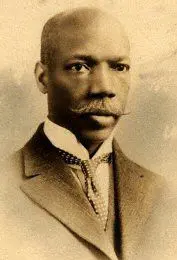Learn about Wendell Dabney, Jr.
Wendell Phillips Dabney was born in Richmond, Virginia, the son of former slaves. Dabney’s father had the necessary training and reputation as a cook and bartender to open a catering business after the Civil War and earn a higher standard of living for his family. Young Wendell graduated from Richmond High School in the first integrated graduation ceremony.
An intelligent and erudite man, Dabney was also an avid reader and a talented musician. In 1883, he enrolled at Oberlin College as one of 15 African American students Oberlin College. During his first year, he was the first violinist at the Oberlin Opera House and a member of the Cademian Literary Society.
Unfortunately, Dabney left college after one year to help support his family. For the next several years, he worked in Virginia as a waiter and then as a teacher until he moved to Boston to start a music studio.
In 1894, Dabney came to Cincinnati to see about a property willed to his mother. He intended to stay only for a few months; however, he met Nellie Foster Jackson, a widow from Indiana with two sons, whom he married in 1897.
Related Article: The History of African Americans in Cincinnati

Dabney decided to settle in Cincinnati, so he improved the property left to his mother and established a music studio. He began teaching music to many prominent Cincinnati families and eventually became involved in politics. Dabney served as the first African American city paymaster and was the first president of the Cincinnati NAACP Chapter.
In 1902, Dabney launched the Ohio Enterprise newspaper, the predecessor to The Union, to be a voice of protest from the African American community. Although Dabney accepted funds from the Republican Party for the newspaper and endorsed Republican candidates, he remained critical of their treatment of his people. In the early 1920s, however, Dabney broke with the Republicans and worked with the City Charter Committee shortly after.
Related Article: 20 Good Books about Race, Diversity, and Inclusion

In addition to his publishing activities, Dabney authored books and composed music. He published Cincinnati’s Colored Citizens in 1926. He wrote Maggie L. Walker: The Woman and Her Work, a biography of one of his longtime friends who became the first African American woman to own a bank.
Dabney also published Chisum’s Pilgrimage and Others, a collection of his writings from The Union. His musical compositions include You Will Miss the Colored Soldier, My Old Sweetheart, and God, Our Father, a Prayer.
Wendell Dabney championed the causes of African Americans until he died in 1952.
Sources
Cincinnati History Library and Archives – cincymuseum.org
About The First 28
The First 28, graciously sponsored by the Greater Cincinnati Foundation, celebrates Black Cincinnatians who were the first in their fields. Each day during Black History Month, we will celebrate athletes, artists, business leaders, civil rights activists, educators, physicians, and politicians.
The Voice of Black Cincinnati is a media company designed to educate, recognize, and create opportunities for African Americans. Want to find local news, events, job postings, scholarships, and a database of local Black-owned businesses? Visit our homepage, explore other articles, subscribe to our newsletter, like our Facebook page, join our Facebook group, and text VOBC to 513-270-3880.
Images provided by Cincinnati Museum Center and Amazon
Comments are closed.